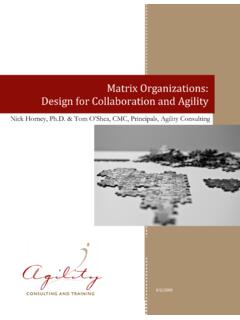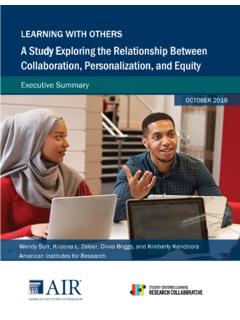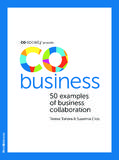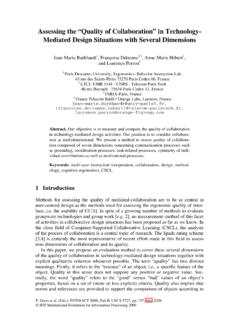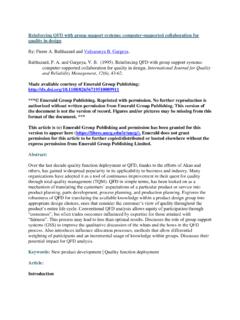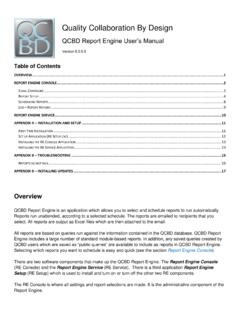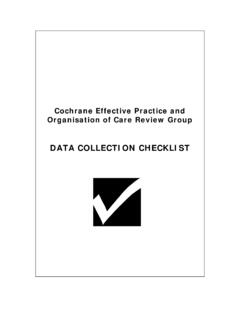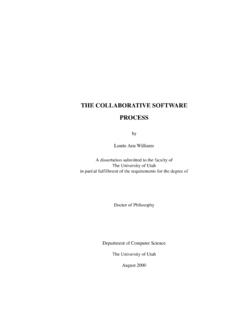Transcription of The Role of Robotics Teams Collaboration Quality on Team ...
1 The Role of Robotics Teams Collaboration Quality onTeam Performance in a Robotics TournamentMuhsin Menekse,aRoss Higashi,bChristian D. Schunn,band Emily BaehrbaPurdue University,bUniversity of PittsburghAbstractBackgroundWorking effectively in Teams is an important 21st century skill as well as a fun-damental component of the ABET professional competencies. However, successful team-work is challenging, and empirical studies with adolescents concerning how the collaborationquality of team members is related to team performance are study investigated the relationship between team collaborationquality and team performance in a Robotics competition using multiple measures of teamperformance, including both objective task performance and expert judge evaluations, on adiverse set of supporting performance included Table Score, Robot design , Research Project, Core Values,and Collaboration Quality scores for 366 youths on 61 K-8 Robotics Teams that participatedin a FIRST LEGO League Championship.
2 Regression and mediation analyses were conductedto explore the relation between effective team Collaboration and team performance. Further-more, analysis of variance was conducted to explore the relationship between CollaborationQuality and team Quality was a good predictor of Robotics team performance across allmeasures ( andp<.001). Mediation analysis revealed that the Robot Designacted as a full mediator for the predictive effect of Collaboration Quality on the Table Score. Inaddition, the cumulative amount of team experience was significantly related to , this study using Collaboration performance assessments and actual com-petition data with a large number of Teams confirms the importance of high- Quality team-work in producing superior products with students engaged in authentic engineering ; collaborative learning; educational Robotics ; informal learning; K-12 IntroductionK-12 Robotics competitions have emerged as popular educational activities in recent years.
3 By2015, more than 230,000 students were participating in 29,000 First Lego League roboticsteams across 80 countries (Close, 2015). Past research has shown that being part of suchrobotics Teams has the potential to significantly influence students academic and social skillsby allowing them to actively engage in critical thinking and problem solving throughJournal of Engineering EducationVC2017 ASEE. 2017, Vol. 106, No. 4, pp. 564 584 DOI , assembling, coding, operating, and modifying robots for specific goals (Bascou &Menekse, 2016; Benitti, 2012). Robotics Teams design solutions for a wide variety of sometimes ill-defined problems. Indoing so, they negotiate an open-ended problem space, taking it upon themselves to identify,investigate, and implement solutions from among a large number of possible learning (PBL) activities such as these have the potential to develop not justtechnical skills but also the professional skills that enable learners to effectively apply theirtechnical knowledge in authentic conditions (Hmelo-Silver, 2004; Hmelo-Silver, Duncan, &Chinn, 2007).
4 Working effectively in Teams is a critical 21st century skill (Borrego, Karlin, McNair, &Beddoes, 2013; Koenig, 2011; Shuman, Besterfield-Sacre, & McGourty, 2005; Tonso, 2006),and teamwork settings are good venues for studying factors in effective team factor or skill of particular interest is Collaboration , or a student s ability to work withpeers interdependently through social cohesion and interaction. This skill is educationallyrelevant in two distinct ways: (a) as a facilitator of interactions that increase content learn-ing, and (b) as an important skill itself (Chi & Menekse, 2015; Clark et al., 2010). Whilesolving challenges as part of a Robotics team appears on the surface to provide students withan opportunity to build Collaboration skills, past research on instructional design suggeststhat the structure of the task affects whether such skills can be fostered (Stahl, 2005), andthe development of effective PBL tasks is particularly critical (Mehalik, Doppelt, &Schunn, 2008).
5 To explore this issue, this study investigated the relationship between team CollaborationQuality and team performance in a Robotics competition using multiple measures of team per-formance. In addition, we explored whether participation in Robotics competitions tends todevelop Collaboration skills by examining the relationship between the Teams cumulativecompetition experience and the Quality of the members Collaboration . Our overall goal was togain insight into how Robotics competitions involve and enhance Collaboration in an authenticway, and to what degree participation in such a competition is likely to develop collaborationskills. The relationships between these factors reflect on both the role of Collaboration andthe authenticity of the competition tasks in relation to engineering tasks where effective col-laboration is widely accepted as being important to success. Our specific research questionsand hypotheses were as follows:RQ 1.
6 What is the relationship between effective team Collaboration and team per-formance outcomes in a Robotics competition?Hypothesis 1. Teams with higher Collaboration Quality scores will produce superiorrobots and score higher in the overall 2. Does participating in Robotics competitions build competency in collabora-tion skills?Hypothesis 2. Teams that have participated in more competitions will demonstratehigher Collaboration Quality structure of the paper is as follows: the Background Section reviews Robotics competi-tions and problem-based learning (PBL), educational Robotics , and Collaboration literature inK-12 formal and informal settings; the Methods Section presents the data sources and teamscores used in this study; the Results Section discusses the analyses conducted and the results; Robotics Teams Collaborative Behaviors and Team Performance565and General Discussion summarizes the findings, concluding by discussing some of the limi-tations of the study and the future work in Robotics CompetitionsRobotics competitions, which have contributed to a broad recognition of educational Robotics ,provide unique opportunities for students and Teams to work toward a shared goal in a certaintimeframe (Bascou & Menekse, 2016; Danahy et al.)
7 , 2014; Eguchi, 2014). Common goalsfor many competitions include the development of academic skills and interest in and aware-ness of science, technology, engineering, and mathematics (STEM); a focus on the ability towork effectively in Teams ; and the development of cooperation and respect toward the otherteams participating in the Robotics competition with the largest number of Teams (not only in the United Statesbut also worldwide) is the FIRST LEGO League (FLL), which began in 1998 as a jointeffort between the FIRST (For Inspiration and Recognition of Science and Technology)Organization and the LEGO Group to introduce Robotics to 9- to 14-year-old is typically voluntary, either as part of an elective class or as an afterschoolactivity. To compete in the FLL, Teams are required to use LEGO kits (Mindstorms robotsets and software) to work on an authentic scientific-themed challenge, with past themesincluding climate change, senior solutions, food safety, and medicine.
8 FLL organizersrelease a challenge each year, after which competing Teams spend the next several monthspreparing for a local Grand Championship competition. At these competitions, team per-formances are evaluated based on scores in four areas: the robot game, a research project,the Quality of Robot design and programming, and demonstration of FLL Core Values(see the Methods Section for more details). The data used in this study come from the2015 FLL Western PA tasks follow a similar value structure as Robotics engineering itself (Jordan & McDa-niel, 2014). Specifically, the robot design component of the FLL competitions, which focuseson mechanical design , programming, and strategy and innovation, is comparable to roboticsengineering competencies. Robotics engineering draws on the expertise of many engineeringdisciplines including mechanical, industrial, electrical, and computer engineering. Similar torobotics engineers, students on FLL Teams are expected to design , build, program, test, andredesign as needed robots and other Robotics devices to meet the challenge of solving authen-tic problems such as using robots for disaster response.
9 These authentic tasks in FLL compet-itions achieve two primary goals: first, they allow students to connect what they learn aboutrobotics to what they could do in the face of real-world challenges; and second, authentictasks and plausible scenarios are structured to motivate students to overcome potential chal-lenges in learning research has shown that such use of educational Robotics can increase interest andengagement in STEM (Kim et al., 2015; Mohr-Schroeder et al., 2014), as well as increasecritical thinking and problem-solving skills (Okita, 2014), computational thinking (Grover &Pea, 2013; Menekse, 2015), mathematics (Alfieri, Higashi, Shoop & Schunn, 2015; Marti-nez Ortiz, 2011), physics (Williams, Ma, Prejean, Ford & Lai, 2007), and science literacy(Sullivan, 2008). For example, Verner and Ahlgren (2004) showed students learned key engi-neering skills such as systems-thinking, problem-solving, and teamwork skills by designing,building, and operating educational robots.
10 Petre and Price (2004) explored the role of566 Menekse, Higashi, Schunn, & Baehrparticipation in Robotics competitions on student development of such engineering designprinciples as determining possible solutions and communicating these solutions to contrast, in a meta-study of Robotics in education, Benitti (2012) found that many edu-cational Robotics studies, in general, remain inconclusive with respect to student learning out-comes. Specifically, Benitti (2012) found three of six experimental or quasi-experimentalrobotics studies exploring student learning outcomes in various subjects ( , mathematics,computation, among others) did not find a significant difference between experimental andcontrol conditions. In addition, at the college level, Fagin and Merkle (2002) conducted alarge-scale experimental study exploring the effects of robots on learning introductory com-puter programming using the Ada/Mindstorms programming environment, finding that thecollege students in the Robotics condition performed worse than their peers in regular com-puter science courses that included no Robotics limited number of studies have investigated Robotics competitions in particular,although these tend to be survey-based rather than performance-based.


